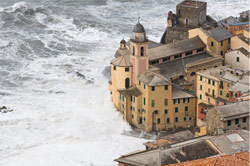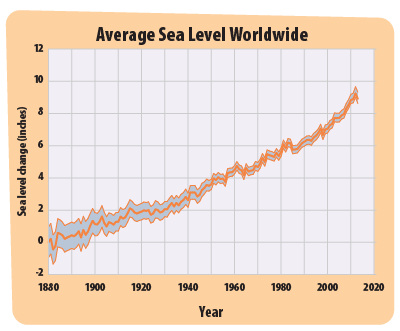Rising Sea Level
 As water gets warmer, it takes up more space. Each drop of water only expands by a little bit, but when you multiply this expansion over the entire depth of the ocean, it all adds up and causes sea level to rise. Sea level is also rising because melting glaciers and ice sheets are adding more water to the oceans.
As water gets warmer, it takes up more space. Each drop of water only expands by a little bit, but when you multiply this expansion over the entire depth of the ocean, it all adds up and causes sea level to rise. Sea level is also rising because melting glaciers and ice sheets are adding more water to the oceans.
What's happening now?

Average sea level around the world has been rising for many years. In this graph, the shaded band shows the likely range of sea level, which depends on the number of measurements and the methods used at different times. Source: EPA's Climate Change Indicators (2016).
Over the past 100 years, the average sea level around the world rose by nearly 7 inches. Did you know that sea level can change by different amounts in different places? Find out why.
Why does sea level change by different amounts in different places?
Sea level is rising faster in some places than others because of wind patterns, ocean currents, and other factors. In addition, sea level may seem like it's changing more in certain places than others because the land itself may be rising or sinking.
In some places, the land is rising or sinking because of plate tectonics—the same forces that cause earthquakes, create volcanoes, and build mountain ranges. In addition to plate tectonics, land can also sink because people have pumped lots of oil, natural gas, or water out of the ground. When the land is also rising, sea level rise might not seem so bad. But in coastal areas where the land is sinking, the effects of sea level rise will be even worse.

What will happen in the future?
If people keep adding greenhouse gases to the atmosphere, the average sea level around the world by the end of this century (the year 2099) could be anywhere from 7 to 23 inches higher than it was in 1990. Sea level could rise even more if the big ice sheets in Greenland and Antarctica melt faster.
Why does it matter?
Rising sea level is a threat to people who live near the ocean. Some low-lying areas will have more frequent flooding, and very low-lying land could be submerged completely. Rising sea level can also harm important coastal ecosystems like mangrove forests and coral reefs.
Check out the major effects of rising sea level on people and the environment:
Learn more about rising sea level by going on an expedition to the Maldives!